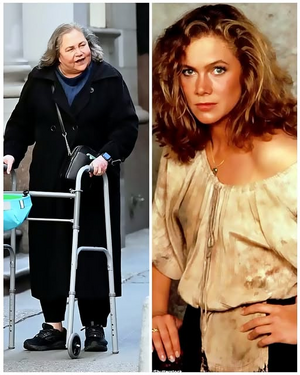Kathleen Turner’s hands had started to swell so severely that gripping a pen felt like pressing on shards of glass. She would often sit in her dressing room before performances, her fingers wrapped in ice packs as she tried to will them into cooperating. On some mornings, she needed nearly an hour to push herself out of bed because her knees locked so tightly she could hardly bend them. All the while, scripts from "Romancing the Stone" and "Prizzi’s Honor" piled up on her nightstand, reminders of the career she had fought to build and now feared she might lose.
She was diagnosed with rheumatoid arthritis during the height of her fame. Doctors explained that her immune system was attacking her joints, leading to unrelenting inflammation. She listened in stunned silence, thinking about the film sets, the long hours in heels, and the close-up shots where she was expected to radiate glamour. Turner chose to keep her condition hidden from most colleagues. She believed if word spread, she would stop receiving offers, and producers would doubt her strength. Every day on set became an act of endurance. She would finish a scene, then step behind a prop to bite her lip and hold back tears from the pain that made even standing feel like punishment.
Tabloids began to speculate about her changing appearance. Gossip columns called her lazy, accused her of losing control, and printed stories about her supposed drinking problem. She felt betrayed by strangers who knew nothing of the private agony she carried. For years, she let the rumors swirl unchallenged, protecting her secret while fighting to keep her work alive. Friends later said that her refusal to explain herself was one of the hardest parts, but Turner believed her performances would speak for her when words could not.
She started a regimen of medications and physical therapy, searching for any combination that could offer relief. Even then, the disease often refused to yield. During the production of "Serial Mom," she would sometimes shoot a scene, then retreat to her trailer to sit with heating pads covering her legs. The director recalled her professionalism and determination, noting how she never allowed her suffering to overshadow the demands of the role. She learned to adjust her movements, plan every gesture carefully, and pace herself to conserve strength.
When the illness worsened, Turner began using a cane off-camera. She dreaded being photographed with it, knowing headlines would spin the image into proof that she was finished. Yet she kept working, pushing herself onto stages and sets because acting gave her a reason to endure the discomfort. Eventually, the weight of secrecy grew too heavy to carry. In interviews, she began speaking openly about the disease, determined to reclaim her narrative.
Opening up became an unexpected source of power. Fans wrote letters describing their own struggles with chronic illness, thanking her for her honesty. She no longer felt obligated to hide her reality behind glossy magazine covers. Turner took comfort in showing that vulnerability did not diminish her. Instead, it revealed a deeper strength than any audience could see on screen.
She also found ways to adapt her work to her limitations. When her joints flared, she accepted voice roles or shorter engagements. She poured her energy into stage productions, feeling that live performance restored a sense of purpose she refused to surrender. Even when every step hurt, she believed the art itself made the fight worthwhile.
The pain never fully disappeared, but Turner learned to coexist with it. She stopped viewing her body as an enemy and started honoring it as the vessel that carried her through every triumph and setback. She once said that rheumatoid arthritis tested her spirit in ways fame never did, and she had no intention of letting it steal the joy she found in her craft.
Kathleen Turner’s courage revealed that resilience grows loudest in the quietest battles, where no one is watching and the only witness to victory is yourself.






































